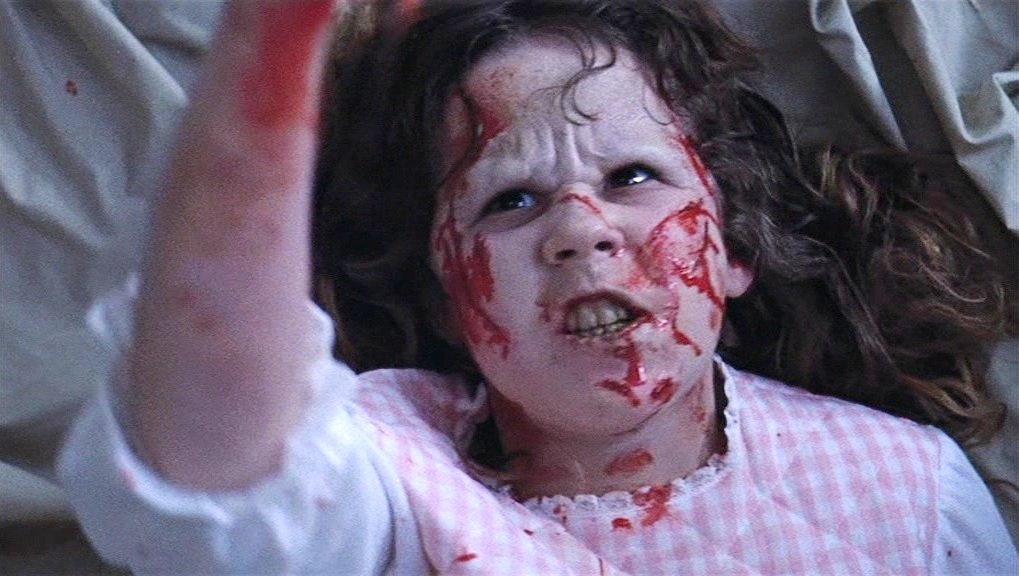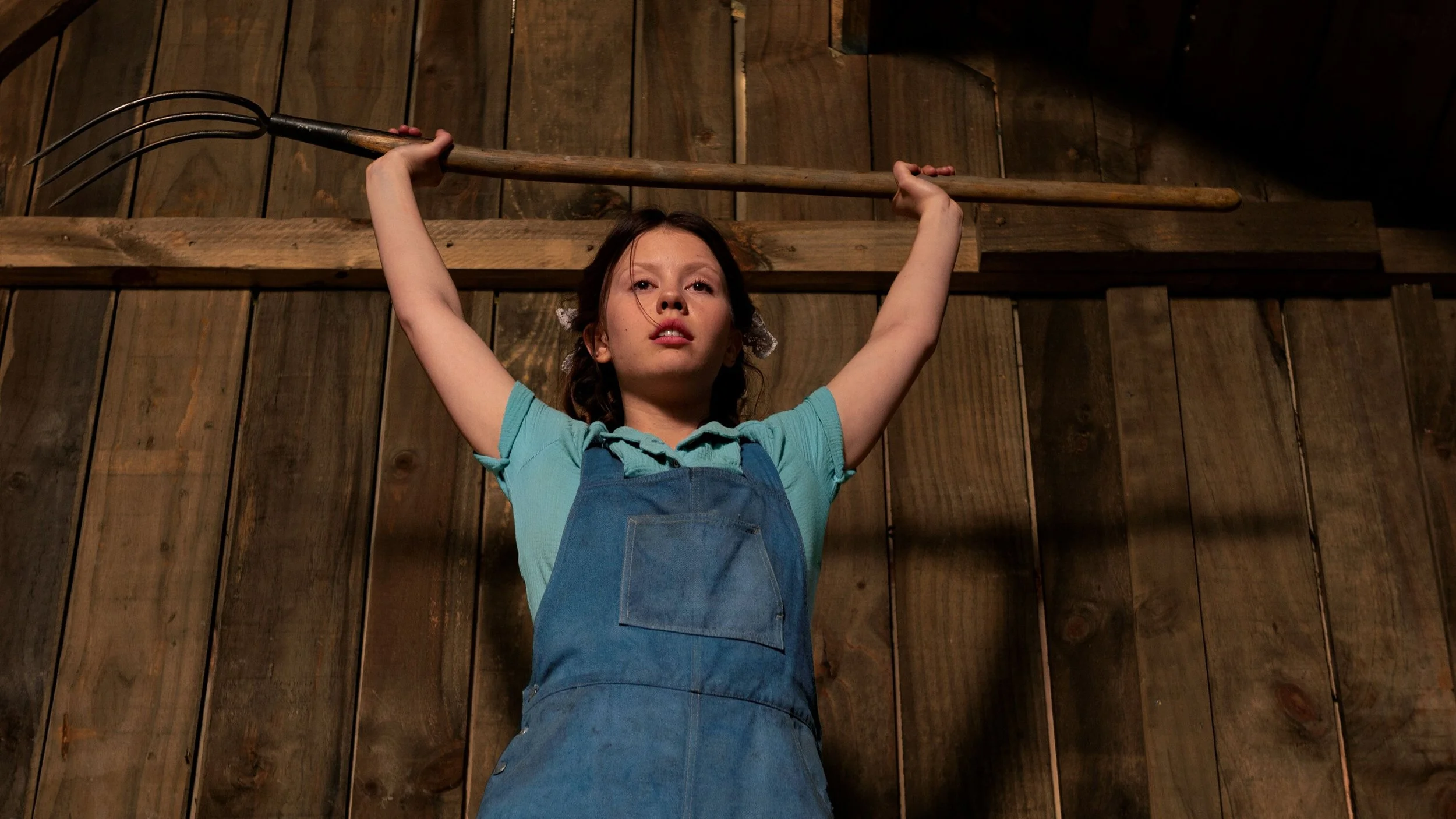A Personal Take on the Evolution of Feminine Rage Through the Lens of Horror
The iconic green and slimy vomit projecting out of a possessed 12 year old, the infamous head spinning, and the staircase gymnastics. It was probably the year 2011 when I first saw The Exorcist. I was the protagonist’s age and appropriately horrified. The scene that shook my anxiety riddled nerves was when Regan, possessed by Pazuzu, repeatedly stabbed herself in the crotch with a crucifix.
To me, the scene was quite straightforward and signified self-inflicted violence. Back in 2011, I did not know the vagina symbolized ‘purity’ and ‘innocence’ for women. The theological crucifix posed a mockery to Christianity for which, the young girl, the supposed protagonist, was nothing but a body. That was not uncommon for Western horror cinema. The 1980s horror genre especially was marked with overused tropes of the virgin final girl or calls of distress from scream queens that gave much more importance to slim waists and untouched hymens than human emotions on screen.
I was brought up in an environment that made me quite afraid of the everyday. A dysfunctional family, my neurodivergent brain, and my complicated body found it difficult to find shelter anywhere real. My shelter was the 16:9 or 4:3 images that gave some solace to my racing heart. The adrenaline rush of watching murder, blood, guts and gore made sense when my heart was racing continuously due to worries I could not make sense of. However, on screen I could make sense of the carnage. Horror movies became a staple as they gave meaning to my anxiety.
However, I was still quite afraid of my femininity. Watching women on screen torn to shreds, exploited for trauma porn or waved around like a trophy in movies made me feel I was no different than a commodity. Much like the damsels in distress on screen, I felt like I was destined to be society’s sacrificial offering – a role I had to play to perfection. These women were fragile, vulnerable and never angry, never sexual. In the eerie realms of ‘Halloween,’ ‘Friday The 13th,’ and ‘Texas Chainsaw Massacre,’ embracing your sexuality was like volunteering for a horror movie death scene. Death by sex seemed imminent and hence the perfect protagonist played into the narrative of being the perfect virgin.
Wes Craven’s transformative work (Scream, 1996) posed different kinds of women for the audience. There was the virgin final girl but there was also the fierce deuteragonist. Courtney Cox played the role of Gale Weathers to perfection. She was an investigative journalist, trying to make a name for herself by using the tragic murders happening in the small town of Woodsboro. She was unhinged in her desire to sensationalise the killings. The murders are a storyline for her and she is feral in her pursuit for them. She is not the most likeable character that dude bros in the 1990s swooned over.
Watching Scream in the 2010s made me hate her as well. I mean, I was a young girl born into a South Asian family, taught to be sensitive, respectful, and tender. Gale was none of those. She was angry, flawed, and inherently human. However, through the years I have found myself becoming more and more like Gale. I find fragments of her deeply embedded into my femininity. I am as feral, angry, and human as she was. Wes Craven’s meta horror flick has continued to gain a heavy following from horror fans. For the feminist in me, it signified women as forbearers of human emotions in horror.
As I grew older and discovered that my body and mind did not have to stick to the roles provided to me by my upbringing, it was refreshing to see women rage on screen. Women were murdered and abused but they were also murderers and primal in their payback. Enter ‘feminine rage,’ the transformative trope that rewrote the horror playbook. Now, women on screen went berserk and how!
Remember Eliot Page in Hard Candy? The revenge flick turned the tables and showed Eliot’s character as feminist fury reincarnated. The campy vibes in Teeth showed the heroine’s journey from being a promise-ring-wearing, abstinence-preaching maiden to someone who embraces the buzz of liberation with a vibrator. Similarly, more contemporary movies like The Witch or Hereditary radicalized women on screen by well, making them human. Anya Taylor-Joy in The Witch didn’t just reclaim black magic; she held it in her fists with a resounding cackling. She found liberation in a cult of witches who freed her from the shackles of a tyrannical family.
Toni Collete broke hearts and dinner tables with her role in Hereditary. A mother grieved at the loss of her child, she was menacing and difficult without being possessed. She held the movie in the palm of her hands with the dinner table scene where she demands, no orders, her son to respect her.
“Don’t you swear at me you little shit. Don’t you ever raise your voice at me! I am your mother!”
Her scream echoed through me and continues to till date. She needed no savior, for she was the one who howled, screamed, and raged like an untamed storm. Resilience was not her shield; she defiantly refused it. She was the perfect tragedy moulded into a woman unapologetically revealing her wounds to the world. Similarly, in Revenge, the French extremist cinema showed a young woman donning guns, shooting, and maiming her enemies and being fierce while doing it. It was cathartic for me to experience women unleashing their wrath on screen. I knew these women who, much like me, found no safe space of expression, let their frenzy engulf the world around them.
I saw a reflection of me in these characters. Like them, I too learnt to scream and rage. I raged against the monsters in the closet, the tyrannical regime close to home if you will. Watching Mia Goth in Pearl ask her admirer, “What did I do wrong? Why are you leaving me, if I didn’t do anything wrong? I don’t understand, I thought you liked me!” pulled some strange strings in my heart. Driven by an unyielding urge, I found myself posing that very question to the contraption that had convinced me my emotions were whispers, never to be spoken loudly, never to be yelled out, never to have an audience.
Gradually, I realized these women were speaking for many young girls like me who were horrified by the mutilation of our bodies because it suited the plot. Our bodies held more than the mere gaze for patriarchy to adore. These women helmed expressions that exploded through aeons of suppression and fear. Their charisma was contagious. For those of us raised on a diet of flawless female protagonists, who were mere marionettes on screen, the sight of women unleashing righteous ferocity upon a system that demanded our silence felt like a rebellion, marked by a gorgeous supernova.
Horror cinema in recent years has awoken a generation of women who are not confined to caricatures of frailty. We take control much like the women on screen. We are ‘crazy’ much like the murderers you see on screen. We are human and our emotions are here to be displayed in all their furious glory. This new era of storytelling is not just heralding a challenge against the patriarchy, but asking many women like me to join the movement. And we are elated to do so. Protagonists on screen are seething and giving voice to feminine rage held down by serial killing generational trauma. The cinematic landscape is evolving to reflect the complexities of what it means to be a woman. As feminine rage continues to set the horror genre ablaze, I am hopeful it lights the way for a more inclusive, diverse, and vibrant future for horror storytelling.
I look forward to filmmakers writing characters like Dani in Midsommar who step up and actively take part in avenging themselves. They smile at the face of brutal violence and do not squirm while reclaiming weapons long hidden from them. Much like Dani, I too hope to find liberation. Albeit without venturing into a Swedish cult that has a penchant for human sacrifices, but maybe through unapologetically carving space for me to be loud. I yearn for more women screaming on screen, I yearn for more women to unleash their fury and I yearn to idolize these ‘crazy’ women. I aspire to become more and more like Gale Weathers or have the maniacal confidence of Pearl. Thanks to them, I am no longer afraid to be angry and I hope this wave gushes over generations to come so they are not traumatized by a crucifix bludgeoning their ‘womanhood.’






